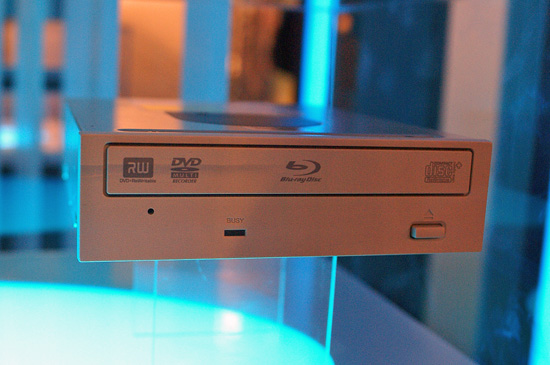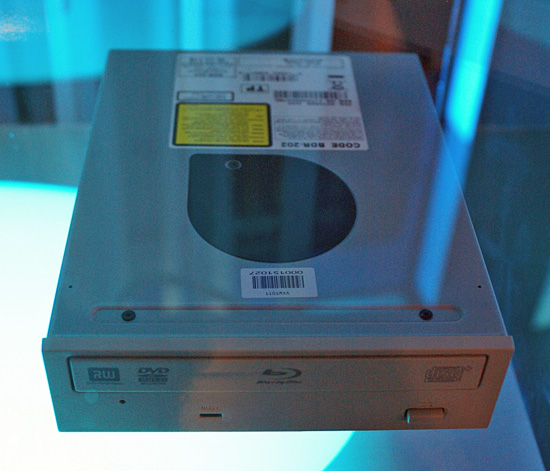CES 2007: Evolutionary not Revolutionary Products
by Gary Key on January 12, 2007 3:00 AM EST- Posted in
- Trade Shows
SanDisk: Solid State Disk Drive

One of the most impressive product demonstrations we witnessed was a comparison between two identically prepared Dell notebooks except for the drive option. One notebook contained a standard 2.5" disk drive while the other one featured the new SanDisk SSD UTAT 5000 1.8" drive with a 32GB capacity. This fifth generation drive features a sustained read rate of 62 megabytes (MB) per second and a random read rate of 7,000 inputs/outputs per second (IOPS) for a 512-byte transfer - up to 100 times faster than most notebook hard disk drives. It also can achieve an average file access rate of 0.12 milliseconds, compared with 19 milliseconds for a typical laptop PC hard disk drive. The SanDisk SSD features an extremely low power consumption rate compared to the laptop hard disk drive: 0.4 watt during active operation versus 1.0 watt which could mean up to 22 minutes or more of additional battery life depending upon usage patterns.
In a demonstration that featured Windows Vista Enterprise edition on each notebook we noticed the SSD equipped system shutdown about 95 seconds faster with four Office applications open at power down . This same configuration booted into Vista and opened the same four Office applications about 115 seconds faster. When resuming from hibernation mode the SSD system took less than five seconds while the hard disk system took close to forty seconds before it was fully functional.
We expect to see these drives to start appearing in OEM systems by the end of Q1 with a price premium around $500 at this time for the 32GB drive. By the end of the year we should expect prices to fall about 40% while drive capacities will increase to 64GB in Q3 and 128GB in Q4. This is a very exciting technology and we should have review samples in the near future.
Pioneer: Blu-ray Combo Drive


Pioneer's first Blu-ray drive featured full read and write capability for Blu-ray and DVD formats but did not have CD read or write capability. The drive was mainly designed for industrial use in creating or playing back Blu-ray discs. Pioneer will be introducing the new BDC-202 drive that offers full DVD/CD read and write features with Blu-ray BD-ROM, BD-R, and BD-RE playback capability. The drive should be available around the beginning of Q2 with an estimated street price below $399 and features a true SATA interface.
Our next article will feature products from Antec, Zalman, G.Skill, Creative Labs, NetGear, and others as we finish up our CES 2007 coverage.










25 Comments
View All Comments
yyrkoon - Saturday, January 13, 2007 - link
I know technically that Solid State includes Flash or NAND type memory, but do these devices use Flash, or SDRAM ? Normally, at least around here, we do not call Flash drives "SSD'.mlambert890 - Saturday, January 13, 2007 - link
These are not the SDRAM variety, they are flash. SSD drives (even the ones based on volatile memory) often use flash and the term is pretty much interchangeable. I mean they're all "solid state disks" yes?yyrkoon - Tuesday, January 16, 2007 - link
Technically, yes, they are all solid state. However SDRAM drives offer better performance, and don't suffer from the "10,000 writes, and you're out syndrome". The only real drawback, is that if the drive ever loses power, the data would be lost forever. I think we all could figure out work arounds for this (such as RAID1 accross a SDRAM device, to a real HDD, etc), so for most of us casual users (and perhaps some in enterprise solutions), this isnt really an issue.chucky2 - Friday, January 12, 2007 - link
Thanks!Chuck
DigitalFreak - Friday, January 12, 2007 - link
You guys @ Anandtech think you could get a hold of one of the new Ritek SSD drives mentioned http://www.engadget.com/2007/01/09/riteks-16gb-and...">here for your test?Prices seem to be quite a bit cheaper than the Sandisk, so I'm wondering what the "catch" is.
PandaBear - Friday, January 12, 2007 - link
Not only that. MLC has much lower duty cycle (erase cycle) before die. I have seen data on MLC life and SanDisk/Toshiba can get about 1000-2000 cycles erase, while Samsung can only do 500-1000 right now. I am not sure if I want a drive that can write only 500 cycles, even with wear leveling, on a 32gb drive, for windows.michal1980 - Friday, January 12, 2007 - link
heres hoping to smart drivers/o.s. with a hybrid drives.everyfile that just needs to be read, and very rarely modified should go on the flash porition for fast reading.
everytemp file/ swap file on a harddrive.
my concern would still be writes from stupid things. a file gets access the access data gets modified for example.
Gary Key - Friday, January 12, 2007 - link
The price difference is due to the lower end drives using MLC NAND instead of SLC NAND Flash. We do not recommend using MLC NAND Flash drives as a desktop/laptop replacement due to the performance differences in write speeds. We will be comparing the two formats once the sample drives arrive in a few weeks.michal1980 - Friday, January 12, 2007 - link
seems like every other year the psu needs a new cable. and now its for video cards.Bhhaaa. Why why, why why.
semo - Friday, January 12, 2007 - link
it seemed not so long ago that the psu was one of the most mundane and long living components of a pc. now it is becoming more like any other component with stray standards appearing from nowhere for no reason other than profits.i suspect cases are to follow suit. i'm not sure how they can pull it off but i'm sure we can rely on case makers to think of something.